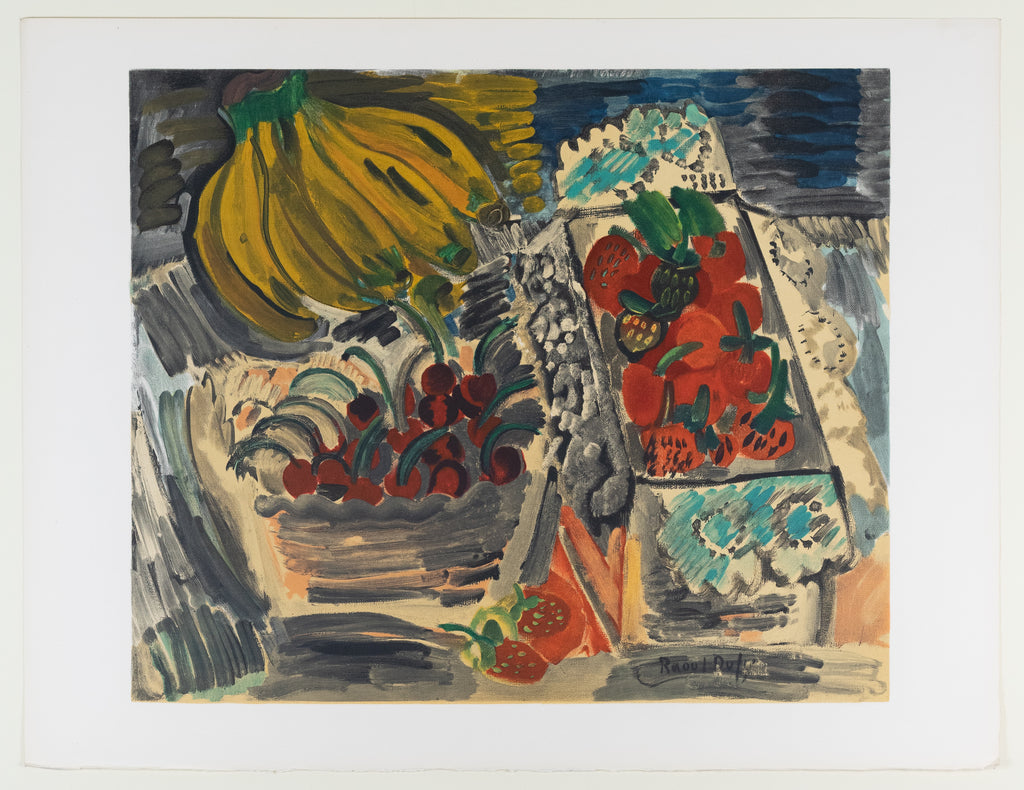Raoul Dufy (1877-1953)(after)
PIERRE LÉVY COLLECTION
NAME: Nature Morte Aux Fruits
ENGLISH NAME: Still life with Fruits
MEDIUM: Lithography on Arches paper
SIGNATURE: Signed in Plate
IMAGE is ACTUAL WORK
Please contact us to request further information or additional images.
(translated from the Pierre Levy collection)
Still Life with Fruits
This still life interests us by its ambivalence. The general design, in particular that of the bananas, the stems of cherries and the scalloped edge of the cup, is treated in arabesques which respond to each other and the tail compensates, on the right, the rigid rectangle of the basket of strawberries, placed at an angle.
This composition is extremely tight; almost mechanical arrangement by someone who has just completed a long internship in the decorative arts. However, in this year 1919 when the table seems to have been painted, the artist is freed from his decorative constraints and before resuming himself to new purely pictorial research, it seems that he wanted, on this small square of canvas, to avenge his past constraints and throw himself headlong into “painting painting” and the sensual joys of the brushstroke. Although in a fairly dark range, this still life is particularly smooth.
There is another version called The Strawberry Basket, dated 1927 and probably painted with the memory of the first. The basket is placed there alone, on a large colored beach where a few scattered strawberries scatter, but the whole denotes pictorial concerns of a now different order.
Raoul Dufy (1877 - 1953) was french painter and the brother of Jean Dufy. But he was not only a painter, but a draftsman, printmaker, book illustrator, scenic designer, furniture designer and planner of public spaces. Dufy grew up in a large family from Le Havre in Normandy, France. At eighteen years old, he started night classes at the Le Havre École des Beaux-Arts school. There he met Othon Friesz who became his lifelong friend. During this part of his life, he was painting mostly landscapes.
In 1900 he won a scholarship to the École Nationale Supérieure des Beaux-Arts in Paris. He joined up with Friesz again. In addition, he was heavily influenced at the time by Claude Monet and Camille Pissaro. He began exhibiting at Berthe Weill’s gallery and the Salon des Indépendants which started to boost his confidence. It is said that Henri Matisse’s Lux, Calme et Volupté was what caused him to move toward Fauvism. He spend the next 15 years exploring this genre, but in 1920 he was testing Cubism. As he developed his own approach to this style, he created vibrant oils and watercolors with yacht scenes, the French Riviera, parties and musical events.
Dufy is known for his very large painting, the fresco La Fée Electricité for the Paris Expo in 1937. He continued to exhibit in the 1940s and early ‘50s until his hands were struck with rheumatoid arthritis and he struggled to paint. He went to the US for an experimental treatment and it was successful which allowed him to continue with his painting until his death.
Raoul Dufy died in 1953 and is buried near Matisse.



